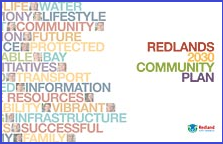

We need to join the dots
Joined-up planning, evidence based planning and adaptive planning processes are the lynch pins to effective economic development (or any other type of) planning. It is about “joining the dots”.
The draft Economic Development Strategy fails to join the dots because it does not address and integrate with other works including:
1. Economic Development Strategy 2008-2012
The Redland City: draft Economic Development Strategy and its compendium document make some broad assertions about the failings of the (previous) Redlands City Council Economic Development Strategy 2008-2012. But we not provided with any rigorous assessment of what the previous strategy set out to do and how well it performed.
At the start of the consultation process for the draft new strategy the community should have been given an evidence based evaluation of the previous strategy. Even a simple SWOT analysis would have been smart way to get community involvement.
2. Redlands 2030 Community Plan
The draft Economic Development Strategy should have clearly built on the community aspirations developed in the Redlands 2030 Community Plan. A Plan that has been endorsed by by both the previous and current City Councils.
The Redlands2030 “Community Plan is important“ article outlines how the Plan is the voice of the people – ‘the people’s plan’. It expresses the hopes and aspirations of our community. It documents our vision for the future and provides a clear and detailed description of what that future should look like. It is a widely lauded Plan.
The Community Plan describes the economic aspirations for the City in the section “Supportive Vibrant Economy” . It should have been compulsory reading for the authors and a keystone of the draft Strategy.
3. RDA Logan & Redlands Regional Roadmap 2013 – 2016
Redland City Council collaborates with Logan City Council in the Regional Development Australia (RDA) Committee under a Committee established by Regional Development Australia: RDA Redlands Logan. This and like committees across the country have employed staff and the support of local Councils. The RDA Committee is required to develop a Regional Plan in Queensland. These economic development plans are known as Regional Roadmaps. They articulate each RDA committee’s economic, environmental and social vision for the region and underpin the work and priorities of the committees. The Regional Roadmaps cost over $100 000 to develop. The RDA Logan & Redlands Regional Roadmap 2013 – 2016 is publicly available. YET, there is no mention of the roadmap in the draft Economic Development Strategy.
Contemporary planning, of all types needs to demonstrate that the process is ‘joined up’ or integrated with other initiatives and related initiatives. Why does the community have to search for what should be a building block of the City’s economic future?
4. Redlands Sustainability Study
Another apparent gap in the Plans citations, is the Redlands Sustainability Study: Final Report 21 November 2011. This study identifies a series of environmental, economic and social indicators that influence sustainable population management and liveability in the Redlands. The report states that it will inform future planning…and associated strategies.
This report at least recognises the interdependencies in planning, economic development, livability, lifestyle, environmental, cultural and social outcomes. Yet, the draft Strategy omits any reference to it.
5. Queensland Plan: Queenslander’s 30-year vision
Finally, Queensland’s LNP government has been working on the much touted Queensland Plan: Queenslands 30-year vision. The foundation ideas in the Queensland Plan are to be enshrined in legislation as a demonstration of the Government’s commitment. While the final Plan was released during the community consultation on Redlands draft Economic Development Strategy, it has been and was in preparation for over a year.
Some critical issues emerge in the Queensland Plan that impact on the Redlands and its economic development. The intent to cater for 50% of the State’s future population growth in regional areas (i.e. outside the SE corner) is profound. It is likely to have a significant impact on the Redlands economy by reducing the City’s population growth rate which will mean less need for new housing developments.
Some of the key issues (goals and targets) of the Queensland Plan that impact on the Redlands Economic Strategy are:
- Queensland cities will go up not out
- Queensland has the best balance of environmental protection and economic development in Australia
- We attract bright minds to Queensland
- Double the regional population outside the south east
- Green spaces are part of our long term plan
- Natural environment has economic value
- Decisions are based on evidence
- Environment remains a tourism and migration drawcard
- Queensland is the best place to live (in Australia) securing greenspace to secure overall health and well being
There is no mention of the Queensland Plan (or the draft that preceded it) in the draft Economic Development Strategy yet its impact was foreseeable. The question must be asked – How will the Redlands Economic Development Strategy be aligned to the new Queensland Plan, especially its intent to shift population growth to other areas of Queensland?
6. Rural Futures Strategy
The review of the Redlands City Rural Futures Strategy (RFS) has been described as a “hatchet” job on the potential for ongoing rural based industries in the City.
The extent of the vision for the sector is just about limited to:
Ensuring the long term future of the poultry industry and of Sirromet Winery are important considerations and Council should look at ways it can assist these industries to ensure their long term contributions to the Redlands.
It is of concern to many that the review demonstrates insufficient knowledge, expertise and understanding of rural activities and peri-urban land use. In its current form, the report in the compendium will ensure that any prospective investors in this Sector would be very wary of spending their money in this City. If the draft report is adopted it would be clear Council has no real interest in the rural sector and it would be subordinate to the other Industry Sectors.
Recent research into peri-urban planning by has been offered to Council, but there seemed to be little acceptance of this work at the forums. This aspect of the draft Strategy needs to be revised.
It is recommended that Rural & Hinterland is added to the list of Key Industry sectors in any Economic Development Strategy.
7. Redlands Tourism Strategy
The Redland City Council Tourism Strategy 2010-2014 (TS) makes some comments about its implementation including a ‘lack of clear direction in relation to the key outcomes” and “there may be a disconnect between the current Mayor’s tourism vision and management’s implementation”. The Research Compendium suggests a future TS should ‘cascade down” from the economic development strategy. It appears Redlands Tourism Strategy will be some time coming despite tourism being one of drivers of the Queensland economy. This is a concern for the future of North Stradbroke Island which is said by some to have been “ignored” in the draft Economic Development Strategy.
More broadly there is an economic imperative to protecting our environmental assets, which are the drawcard to tourism. It would be ironic so much of the “growth driven” economy being advocated by the draft Strategy could devalue those very assets that we (and others) value. Think koalas, and other fauna, bushland, scenic amenity, village style urban areas and water quality both in creeks and “the Bay”.
The draft strategy does not take us anywhere
Learning from the past rather than starting all over again is smart and contemporary planning. To this end, it may have been useful to analyse community feedback given to the authors of the old Strategy. The Compendium asserts that the old EDS “lacked an “economic vision” and was too broad and high level and lacked clear objectives. It appears to be a document of “intent” rather than a strategy that clearly outlines the economic development direction of Redlands”. Like or similar criticism has already been made of the proposed new Strategy. In fact, the headline recommendation (intent) of the “new” approach is to create an Advisory Committee!
The terms of reference for the new Committee are contradictory and even confused. A major role of the Committee is said to be to “oversee the implementation of the Draft (sic) Economic Development Strategy”.
But there is duplication because of the role of “Council employees” who are also “required … to oversee the draft (sic) strategy’s implementation“. It may be pedantic, but why would anyone oversee implementation of a draft strategy and why would overseeing be the responsibility of officers AND the Committee. Poor writing is often a sign of poor thinking.
But the real dilemma seems to be that the new draft Strategy identifies “Strategies required by Council employees …will need to include, but not limited to:
- attracting investment
- encourage innovation/ value-add
- skill development – Note: the compendium of the previous Strategy asks: “What will the workforce be trained in?”
- lifestyle promotion/ perception changing
- securing funds/ collaborative partnerships
If Council staff are required to do all of (but not limited to) these tasks, then what would the Committee do? If Council officers were to be successful in “attracting investment” there won’t be a need for a Committee.
So we have a Strategy pointing to a need for strategies, which is a plan to plan, and calls for a Committee to duplicate the work of staff.
Where to now?
The complexity of economic planning is a reality! Simplistic, populist and one dimensional solutions have too often turned out to be simply action for the sake of being seen to do something. The Redlands community deserves better.
One attempt to “sell” the draft Strategy was the (very) delayed release of the Research Compendium. It is hard for community organisations to respond to a cascade of documents within the short consultation period. Most community groups only meet once a month, so action is hindered when documents appear with less than 6 weeks to close of a submission phase. Council should be encouraging and assisting community engagement, not frustrating it.
The Strategy’s Compendium is not a well-written fluid document, and probably was not meant to be. It seems to be more an afterthought – perhaps a response to widespread criticism at the early community forums. It was perhaps not intended for “public” consumption. At page 6 the following statement will stop most people : “In addition, the philosophical positions adopted in the compendium do not prescribe to one particular ontological, epistemological or axiological stance, but instead use a variety of these throughout the work (Saunders, 2009).” This calls for a dictionary, where the following definitions were found:-
Ontology – department of metaphysics concerned with nature of being
Epistemology – theory of method or grounds of knowledge
Axiology – the study of the nature of values and value judgements
People can make their own judgement as to the value this section, but it is likely to add little to community comprehension of the City’s economic reality or the future.
The Final Picture
The draft Economic Development Strategy has failed to “join the dots”. It should be withdrawn and re-written in concert with the stakeholders and the community. Addressing 60 people who attended the three “Community Consultations” cannot be said to represent the views of almost 150,000 residents and certainly should not be used to counter the structured analysis of the over 3,000 who participated in developing the Redlands2030 Community Plan.
Please note: Offensive or off-topic comments will be deleted. If offended by any published comment please email thereporter@redlands2030.net



